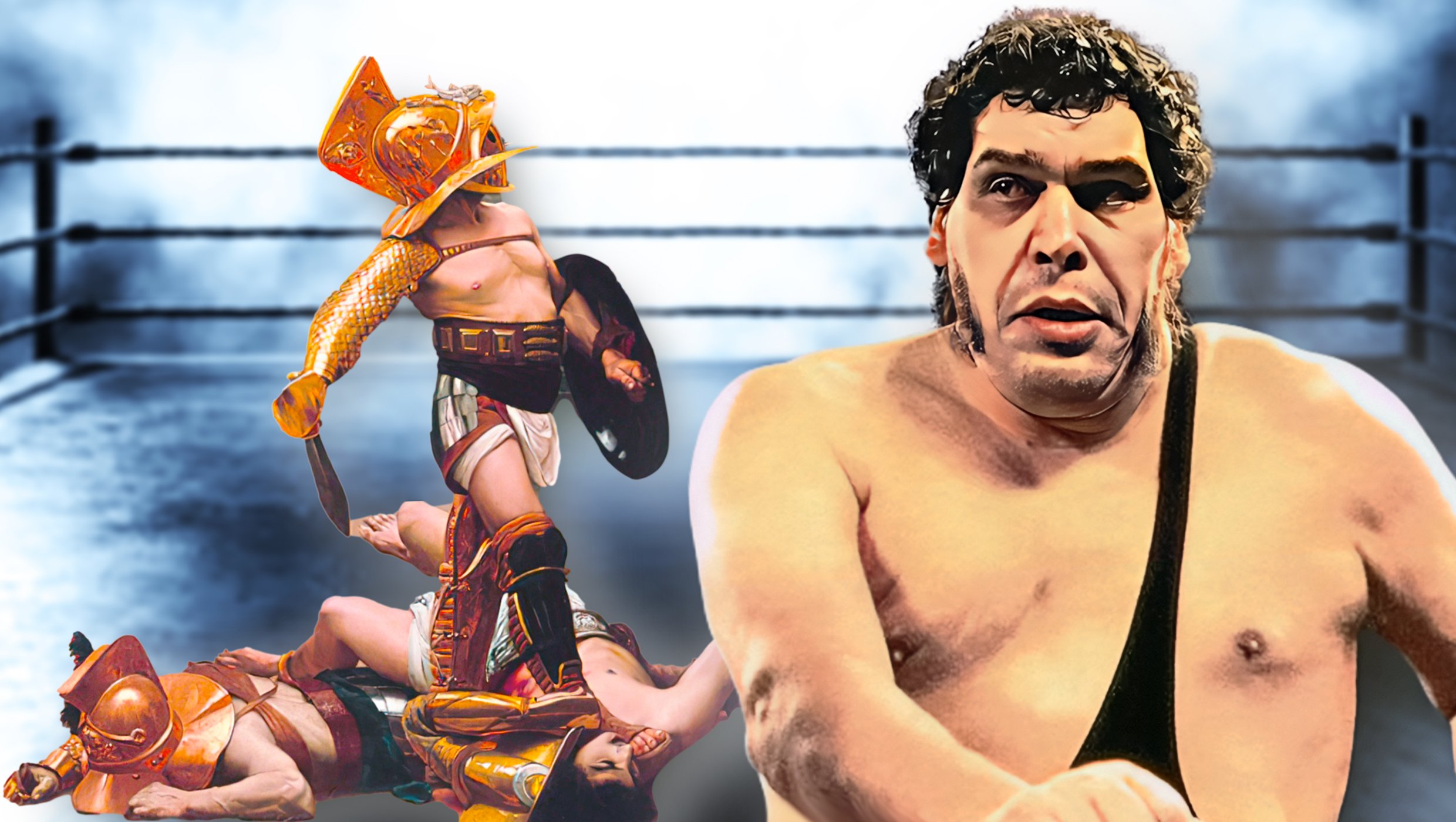The ages may separate ancient gladiators and pro wrestling, but if you dig deep, you’ll discover shocking, unexpected ties between fighters of old and new!

Quick Tip for Facebook Readers
Many of our readers connect with our content through our Facebook page. However, Meta's built-in browser (which opens by default on mobile) occasionally freezes mid-article- a known issue unrelated to our site. To enjoy uninterrupted reading: Tap the three dots in the top right corner → Select 'Open in external browser.' This will resolve the glitch. Thanks for your support. We want your wrestling stories to stay as smooth as a top-rope hurricanrana!
How Pro Wrestling Has Taken a Cue From Ancient Gladiators
One major similarity cannot be understated when looking at the combat of ancient gladiators and modern professional wrestling: spectacle trumps everything.
In the early centuries of gladiatorial combat, fighters were introduced through a grand entrance, fought in the middle of circular arenas packed with spectators, experienced glory and honor through winning, and were major cultural icons.
Today in professional wrestling, the circular arena, theatrical entrance, and star power can all be found.
We’re not suggesting that gladiatorial combat was scripted like wrestling, but it was planned to be as much of a spectacle as possible.
Pro wrestling learned a lot from gladiatorial combat, including the emotional bonding between a crowd and the fighter, dramatized entrances, the shape of the arena, and more.
Let’s dive further into surprising similarities.
Were Ancient Gladiators the Original Professional Wrestlers?
Most ancient gladiators were slaves or prisoners and were dressed for combat in different styles depending on geography and the type of gladiator.
Like professional wrestling, the performers had little creative control and wore different gear depending on their style or gimmick.
The differing costumes and outfits both parties wore helped the audience distinguish who they would root for and what each combatant stood for.
In addition, the gladiators were introduced to the arena similarly to modern-day professional wrestlers.
Wrestling entrances today feature loud music and outfits that elicits an emotional response from the crowd. Even in those ancient times, many gladiators made grand entrances before their big fights.
A Connection with the Fighters
One of the most fascinating similarities between the two cultural giants is how the crowd bonded emotionally with a fighter.
In ancient combat, many ancient gladiators wore masks so the crowd could not see the fighter’s face. Much like masked wrestlers of today, ancient fighters used over-the-top movements so that the crowd could form an emotional bond with them despite not being able to see their facial expressions.
Emotionally bonding with a performer is possibly the most critical aspect of professional wrestling, which is taken straight from gladiatorial combat.

This is why many gladiators were masked or armored, so the audience could not spot their pain, or the injuries acquired.
It seems as though the Roman crowd was bothered by these visuals, especially if it was a woman or a mother in combat.
The story of Perpetua, a woman rejected by the fans because she was lactating, was easily solved by simply putting a shirt on her so the fans could not see the lactation.
As long as it was out of sight, it was out of mind.
In pro wrestling, however, wrestlers are told to look up at the audience when they are in pain and even use their costumes to garner emotion.
The emotional bonds between fans and characters drive the narrative of storylines in pro wrestling, and the idea of connecting to a character through seeing their face is often used in pro wrestling.
An iconic example of this was at WrestleMania 13 when Stone Cold Steve Austin screamed in agony as Bret Hart locked him in The Sharpshooter.
Austin’s face was stained red, and he reached for the audience in agony as he eventually passed out from the pain and lost the match.
Ever since that moment, the crowd has had an undeniable connection with Austin because they felt that moment’s emotion, violence, and importance through seeing Austin’s face.

However, even back then, it was understood that an emotional bond between audience members and fighters could and would happen and drastically affect the audience’s opinions of each fighter.
The Stardom of Ancient Gladiators and Professional Wrestlers
Another striking similarity between the two spectacles is the stardom that a successful fighter can experience.
In ancient Rome and other cultures with spectacle fighting, such as Spartan warriors, the most successful went on to experience fame and power.
For example, many ancient gladiators were said to have gone on to endorse tools or products and, more importantly, run for political office.
Fighters used their newfound fame to catapult themselves into a higher place in society.
This is very similar to how former wrestling stars, such as “The Rock” Dwayne Johnson, have moved on from wrestling to acting, social work, branding, and more.
In 2017, he even joked he would run for president.
Dwayne Jonson is the highest-paid actor in Hollywood, and he got his start in the WWE. This is very telling about how popular ancient combat and modern-day pro wrestling are with the general population.
In both cases, the people that went to see it, and society as a whole, valued it as a sport, an art, and a piece of their culture.
![Ancient Gladiators and Pro Wrestling: Surprising Ties Uncovered "The Rock" Dwayne Johnson: The world's highest-paid actor. [Photo: Forbes]](https://prowrestlingstories.com/wp-content/uploads/2022/10/word-image-76616-4-e1673967957809.jpg)
With hundreds of amazing Pro Wrestling Stories to dive into, where do you start? Get the inside scoop – join our exclusive community of wrestling fans! Receive 10 hand-picked stories curated just for YOU, exclusive weekly content, and an instant welcome gift when you sign up today!
Giving Your Life to the Art of Battle
It is often assumed that it was the decision of the crowd or judges to spare the gladiator’s life based on their effort in the brawl. In ancient combat, a thumb up or down often decided the fate of a fighter.
Thumbs up or thumbs down is similar to how wrestling fans react to the product.
Wrestling fans are notorious for being harsh critics of the art. If treated to a match considered uninteresting, fans inevitably chant, “This is boring.”
However, if the match is deemed good, spectators will make it obvious that they want more with chants such as “Fight forever!” or “This is awesome!”
“At WWWF Madison Square Garden shows in the 1970s and 1980s, when the heel came up covered in a crimson mask, a murmur turned to a roar. There was a palpable bloodlust in the air,” remembers Evan Ginzburg, associate producer for the films The Wrestler and 350 Days.
“We were mostly blue-collar ‘mark’ fans who ‘believed’ and wanted our hero to brutalize their enemy. I always imagined it similar to the ancient gladiators from the Roman Colosseum.”
Although gladiatorial combat often ended in injuries and used real weapons like a trident instead of a steel folding chair, the risks in professional wrestling are real and sometimes unavoidable.
Wrestlers have died in the ring from moves gone awry and from physical exertion leading to heart attacks.
The ancient gladiators had swords, spears, shields, and armor. Wrestlers have tables, ladders, and knee pads. Yet there are numerous similarities.
Of course, the consequences of losing in each scenario are very different, but the essence of the physical spectacle can not be ignored.
These stories may also interest you:
- Wrestling Injuries That Ended Careers Too Soon
- Joey Mercury – The Injury That Brokedown a Promising Career
- 8 Matches that Left Wrestlers with Permanent Scars
Can’t get enough pro wrestling history in your life? Sign up to unlock ten pro wrestling stories curated uniquely for YOU, plus subscriber-exclusive content. A special gift from us awaits after signing up!
Want More? Choose another story!
Be sure to follow us on Facebook, X/Twitter, Instagram, Threads, YouTube, TikTok, and Flipboard!

"Evan Ginzburg’s stories are a love letter to wrestling, filled with heart, humor, and history. A must-read for any true fan." — Keith Elliot Greenberg
Wrestling Rings, Blackboards, and Movie Sets is the latest book from Pro Wrestling Stories Senior Editor Evan Ginzburg. 100 unforgettable stories—from sharing a flight on 9/11 with a WWE Hall of Famer to untold moments in wrestling history. A page-turner for fans of the ring and beyond. Grab your copy today! For signed editions, click here.
"Evan Ginzburg’s stories are a love letter to wrestling, filled with heart, humor, and history. A must-read for any true fan." — Keith Elliot Greenberg
Wrestling Rings, Blackboards, and Movie Sets is the latest book from Pro Wrestling Stories Senior Editor Evan Ginzburg. 100 unforgettable stories—from sharing a flight on 9/11 with a WWE Hall of Famer to untold moments in wrestling history. A page-turner for fans of the ring and beyond. Grab your copy today! For signed editions, click here.
Pro Wrestling Stories is committed to accurate, unbiased wrestling content rigorously fact-checked and verified by our team of researchers and editors. Any inaccuracies are quickly corrected, with updates timestamped in the article's byline header.
Got a correction, tip, or story idea for Pro Wrestling Stories? Contact us! Learn about our editorial standards here. Ever wanted to learn more about the people behind Pro Wrestling Stories? Meet our team of authors!
ProWrestlingStories.com participates in affiliate marketing programs. This post may contain affiliate links, meaning we may earn commissions at no extra cost to our readers. This supports our mission to deliver free content for you to enjoy!













